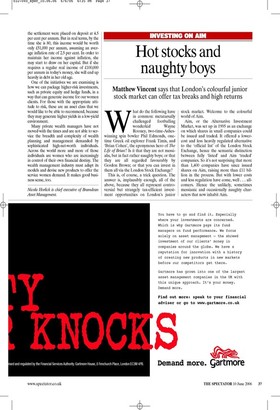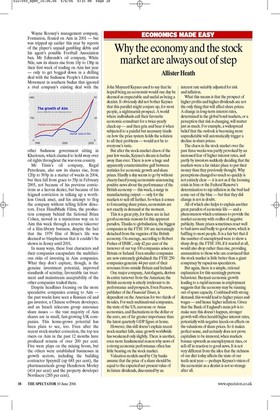INVESTING ON AIM
Hot stocks and naughty boys
Matthew Vincent says that London’s colourful junior stock market can offer tax breaks and high returns What do the following have in common: metatarsally challenged footballing wonderkid Wayne Rooney, two-time-Asheswinning spin bowler Phil Edmonds, onetime Greek oil explorer Frank Timis, and ‘Brian Cohen’, the eponymous hero of The Life of Brian? Is it that they are not messiahs, but in fact rather naughty boys; or that they are all regarded favourably by Gordon Brown; or that you can invest in them all via the London Stock Exchange?
This is, of course, a trick question. The answer is, implausibly enough, all of the above, because they all represent controversial but strangely tax-efficient investment opportunities on London’s junior stock market. Welcome to the colourful world of Aim.
Aim, or the Alternative Investment Market, was set up in 1995 as an exchange on which shares in small companies could be issued and traded. It offered a lowercost and less heavily regulated alternative to the ‘official list’ of the London Stock Exchange, hence the semantic distinction between fully ‘listed’ and Aim ‘traded’ companies. So it’s not surprising that more than 1,400 companies have since issued shares on Aim, raising more than £11 billion in the process. But with lower costs and less regulation have come, well ... allcomers. Hence the unlikely, sometimes messianic and occasionally naughty characters that now inhabit Aim. Wayne Rooney’s management company, Formation, floated on Aim in 2001 — but was tripped up earlier this year by reports of the player’s unpaid gambling debts and his agent’s possible Football Association ban. Mr Edmonds’s oil company, White Nile, saw its shares rise from 10p to 138p in their first week of trading on Aim last year — only to get bogged down in a drilling deal with the Sudanese People’s Liberation Movement in southern Sudan that ignored a rival company’s existing deal with the other Sudanese government sitting in Khartoum, which claimed to hold sway over oil rights throughout the war-torn country.
Mr Timis’s oil company, Regal Petroleum, also saw its shares rise, from 120p to 509p in a matter of weeks in 2004, but then fall from grace to 35p in February 2005, not because of his previous convictions as a heroin dealer, but because of his feigned conviction in talking up a worthless Greek asset, and his attempt to flog the company without telling fellow directors. Even HandMade Films, the production company behind the fictional Brian Cohen, moved in a mysterious way on to Aim this week through a reverse takeover of a film-library business, despite the fact that the 1979 film of Brian’s life was deemed so blasphemous that it couldn’t be shown in Jersey until 2001.
In many ways, these four characters and their companies encapsulate the multifarious risks of investing in Aim companies. What they don’t capture, though, is the genuine investment potential, improved standards of scrutiny, favourable tax treatment and mainstream acceptability of the other companies traded there.
Despite headlines focusing on the more speculative companies coming to Aim the past weeks have seen a Russian oil and gas investor, a Chinese software developer, and an Israeli telecoms group announce share issues — the vast majority of Aim shares are in small, fast-growing UK companies. This home-grown potential has been plain to see, too. Even after the recent stock-market correction, the top ten risers on Aim in the past 12 months have produced returns of over 200 per cent. Five were plays on the mining boom, but the others were established businesses in growth sectors, including the building contractor Speymill (up 685 per cent), the pharmaceuticals group Henderson Morley (414 per cent) and the property developer Northacre (285 per cent).



















































































 Previous page
Previous page